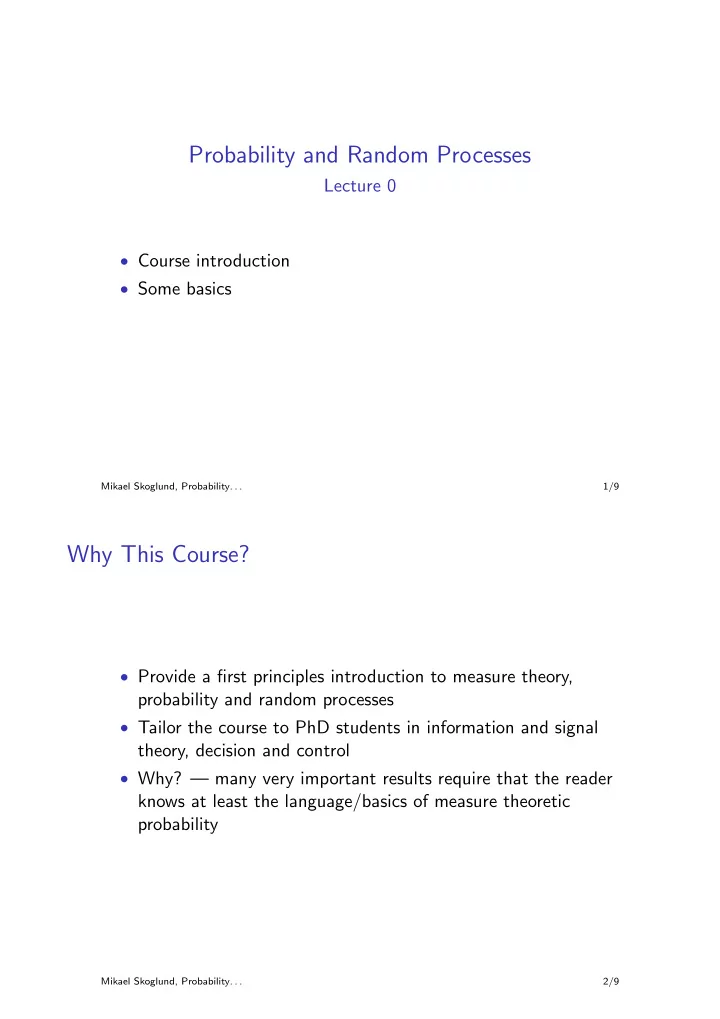

Probability and Random Processes Lecture 0 • Course introduction • Some basics Mikael Skoglund, Probability. . . 1/9 Why This Course? • Provide a first principles introduction to measure theory, probability and random processes • Tailor the course to PhD students in information and signal theory, decision and control • Why? — many very important results require that the reader knows at least the language/basics of measure theoretic probability Mikael Skoglund, Probability. . . 2/9
Some Basics • R = the real numbers • R ∗ = R ∪ {∞ , −∞} = the extended real numbers • Q = the rational numbers • Z = the integers • N = the positive integers (natural numbers) Mikael Skoglund, Probability. . . 3/9 • A set A of real numbers • a = sup A = least upper bound = smallest number a such that x ≤ a for all x ∈ A • b = inf A = greatest lower bound = largest number b such that x ≥ b for all x ∈ A • Density of Q in R • between any two real numbers, there is a rational number • between any two rational numbers, there is a real number Mikael Skoglund, Probability. . . 4/9
• A set A ⊂ R is open if for any x ∈ A there is an ε > 0 such that ( x − ε, x + ε ) ⊂ A • A ⊂ R is an open set ⇐ ⇒ A = countable union of disjoint open intervals • The number b is a limit point of the set B if any open set (open interval) containing b also contains a point from B • The closure of B = { all B ’s limit points } ⇒ B c is open • B is closed if it’s equal to its closure ⇐ Mikael Skoglund, Probability. . . 5/9 • A sequence { x n } , x n ∈ R • a = lim sup x n ⇐ ⇒ for any ε > 0 there is an N such that • x n < a + ε for all n > N • x n > a − ε for infinitely many n > N • b = lim inf x n ⇐ ⇒ for any ε > 0 there is an N such that • x n > b − ε for all n > N • x n < b + ε for infinitely many n > N • c = lim x n ⇐ ⇒ a = b = c Mikael Skoglund, Probability. . . 6/9
• A function f : R → R • a = lim x → b f ( x ) ⇐ ⇒ for any ε > 0 there is a δ > 0 such that | f ( x ) − a | < ε for all x ∈ ( b − δ, b + δ ) \ { b } • f is continuous if lim x → b f ( x ) = f ( b ) f − 1 ( A ) open for each open A ⊂ R , where ⇐ ⇒ f − 1 ( A ) = { x : f ( x ) ∈ A } Mikael Skoglund, Probability. . . 7/9 • A sequence of functions { f n ( x ) } • f n → f pointwise if { f n ( a ) } has a limit for any fixed number a , that is, for any ε > 0 there is an N ( a ) such that | f n ( a ) − f ( a ) | < ε for all n > N ( a ) • f n → f uniformly if for any ε > 0 there is an N (that does not depend on x ) such that | f n ( x ) − f ( x ) | < ε for all n > N and for all x Mikael Skoglund, Probability. . . 8/9
• The set of continuous functions is closed under uniform but not under pointwise convergence • If all the f n ’s in { f n ( x ) } are Riemann integrable, then f = lim f n is Riemann integrable if the convergence is uniform, but not necessarily if it’s pointwise • important part of the reason that we will need to look at the Lebesgue integral instead. . . Mikael Skoglund, Probability. . . 9/9
Recommend
More recommend